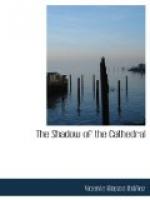He strolled through the naves, attracting the attention of the devotees, who stopped in their prayers to watch him. A stranger at that early hour, which belonged specially to the familiars of the Cathedral, excited their curiosity.
The bell-ringer passed him several times, following him with uneasy glance, as though this unknown man, of poverty-stricken aspect, who wandered aimlessly about at an hour when the treasures of the church were, as a rule, not so strictly watched, inspired him with little confidence.
Another man met him near the high altar. Luna recognised him also: it was Eusebio, the sacristan of the chapel of the Sagrario, “Azul de la Virgen,"[1] as he was called by the Cathedral staff, on account of the celestial colour of the cloak he wore on festival days.
[Footnote 1: Virgin’s blue.]
Six years had passed since Gabriel had last seen him, but he had not forgotten his greasy carcase, his surly face with its narrow, wrinkled forehead fringed with bristly hair, his bull neck that scarcely allowed him to breathe, and that made every breath like the blast of a bellows. All the servants of the Cathedral envied him his post, which was the most lucrative of all, to say nothing of the favour he enjoyed with the archbishop and the canons.
“Virgin’s blue” considered the Cathedral as his own peculiar property, and he often came very near turning out those who inspired him with any antipathy.
He fixed his bold eyes on the vagabond he saw walking about the church, making an effort to raise his overhanging brows. Where had he seen this strange fellow before? Gabriel noted the effort he made to recall his memory, and turned his back to examine with pretended interest a coloured panel hanging on a pillar.
Flying from the curiosity excited by his presence in the fane, he went out into the cloister; there he felt more at his ease, quite alone. The beggars were chattering, seated on the doorsteps of the Mollete; many of the clergy passed through them, entering the church hurriedly by the door of the Presentacion; the beggars saluted them all by name, but without stretching out their hands. They knew them, they all belonged to the “household,” and among friends one does not beg. They were there to fall on the strangers, and they waited patiently for the coming of the English; for, surely, all the strangers who came from Madrid by the early morning train could only be from England.
Gabriel waited near the door, knowing that those coming from the cloister must enter by it. He crossed the archbishop’s arch, and, following the open staircase of the palace, descended into the street, re-entering the church by the Mollete door. Luna, who knew all the history of the Cathedral, remembered the origin of its name. At first it was called “of justice,” because under it the Vicar-General of the Archbishopric gave audience. Later it was called “del Mollete,” because every day after high mass the acolytes and vergers assembled there for the blessing of the half-pound loaves, or rolls of bread distributed to the poor. Six hundred bushels of wheat—as Luna remembered—were distributed yearly in this alms, but this was in the days when the yearly revenues of the Cathedral were more than eleven millions.




